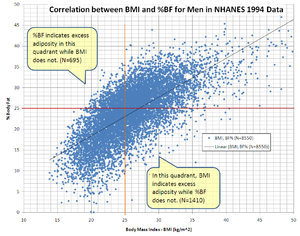Weight by itself is completely meaningless.
You have to put it into the context of a person’s height and build.
Body Mass Index (BMI) is probably the most common way of calculating this using a mathematical formula.
It’s not a new formula, as a bit of research revealed. It’s been around since the 19th century and was originally known as the Quetelet Index, after its inventor Adophe Quetelet.
Since he was Belgian the formula is based on the metric system (woohoo!)
To calculate your BMI you simply use this formula:
| BMI = ( kg/m² ) |
weight in kilograms |
| ———————————— | |
| height in meters² |
The result of the calculation will tell you (roughly) how worried you need to be.
| BMI | Weight Status |
|---|---|
| Below 18.5 | Underweight |
| 18.5 -24.9 | Normal |
| 25 – 29.9 | Overweight |
| 30 & Above | Obese |
Of course if you don’t want to sit down with a calculator and do the math yourself there are plenty of free BMI calculators available online – many of which allow you to input either Imperial or Metric measurements and also offer you the option to compare your results to other people in the same age group.
My own BMI is dropping, as I shed weight (maybe “shed” is a little dramatic, but it sounds good!), but I’m still way above 25. I probably was in the 18.5 – 25 range when I was in my 20s, but I’m now heading towards 40 and getting that number back down is not going to be easy.
But, and this is sort of fun to watch, with every weigh in I can see that number changing. Based on my past experiences weight goes up and down even if you’re doing your best to stick to a diet, so I expect it to fluctuate.
Related articles
- The importance of BMI in measuring weight loss success (yearofthedetox.com)
- Compute Your Body Mass Index (BMI) (lahaven.wordpress.com)
